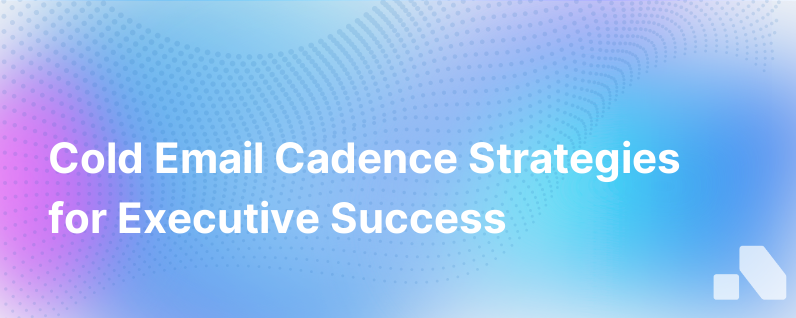
In the realm of modern B2B sales and marketing arenas, cold emailing remains a cornerstone tactic, wielding the power to initiate lucrative dialogues with potential clients. Its success, however, is not rooted in spontaneous, one-off communications, but rather in meticulously structured cadences that bolster the probability of breaking through the noise and resonating with decision-makers.
Cold email cadence is essentially the planned sequence of outreach attempts, encompassing not just the initial cold email, but also a series of follow-ups. These strategically timed communications are designed to nurture prospects, build rapport, and subtly steer them towards considering your offering.
Crafting Effective Cold Email Cadences
The art of devising an effective cold email cadence is predicated on understanding human psychology, contemporary communication dynamics, and leveraging data-driven insights. Let's delve into the strategies that could potentially revolutionize your cold outreach and escalate your response rates.
Understand Your Audience
Embarking on your cadence creation begins with an elaborate understanding of your target audience. Knowing the industry, role, challenges, and communication preferences of your potential clients is quintessential. With this knowledge at your disposal, you can customize your messages to speak directly to their pain points and interests.
Timing is Key
When it comes to outreach, timing can be as critical as the message itself. Research suggests different days of the week and times of day yield varying levels of engagement. Typically, Tuesdays and Thursdays have been noted to have higher open rates, whereas emails sent in the late morning tend to perform well.
However, there's no one-size-fits-all. Test, measure, and refine to find the times that elicit the best response rates from your specific audience.
Define Your Cadence Structure
Cold email cadences generally consist of 6-8 touches over a 3-4 week period, including both emails and possibly other channels like social media for a multi-channel approach. Intervals between emails should be long enough to avoid harassment but frequent enough to stay top-of-mind.
Here's a suggested sequence to give you an idea:
- Initial Cold Email: Introduce yourself, offering a concise value proposition and a clear CTA.
- Follow-Up #1 (2-3 days later): Provide additional value, perhaps a piece of useful content or an intriguing industry insight.
- Follow-Up #2 (3-5 days later): Personalize further, perhaps invoking a recent company milestone or news feature.
- Follow-Up #3 (5-7 days later): Feature a case study or testimonial, showing the benefits achieved by someone similar to your prospect.
- Follow-Up #4 (7+ days later): A soft break-up email, elegantly implying this will be the last reach-out, which can prompt action.
Personalization at Scale
Personalization is imperative but challenging to maintain at scale. Utilize tools that pull in prospect-specific information based on data points like name, company, role, industry, and any other relevant details. Develop templates that allow for customization without requiring hours of manual input per email.
Content That Catches Eye
Your emails should be concise, clear, and engaging. Craft subject lines that pique interest without being clickbaity. The body of your email should provide immediate value and position your offering as a solution to a problem or an enhancer to their business. Ensure the call to action (CTA) is distinct and easy to act on.
Automate and Monitor
Employ tools to automate your cold email cadences, taking manual labor out of the equation. This not only ensures consistency but also provides valuable analytics on open rates, click-through rates, and responses, allowing you to adjust your strategy accordingly.
Follow-Up Etiquette
The follow-up emails should walk the fine line between persistence and nuisance. Each subsequent email must build on the previous one while bringing fresh perspective and added value to the table. Use follow-ups as opportunities to address potential objections and reinforce your value proposition.
Testing and Optimization
Subject lines, email copy, CTA, timing—everything can be tested. A/B testing different variations can unveil what resonates best with your audience. Commit to continuous improvement, incorporating the lessons from your analytics to refine your cadence for optimal effectiveness.
Examples of Cold Email Cadence Success
Let's examine a few theoretical scenarios to demonstrate the power of an adeptly configured cold email cadence.
- A cloud services provider targeting CTOs could lure interest with subject lines like "Cut Your Cloud Spend by 30%."
- An HR consultancy might reach out with "5 Strategies to Boost Employee Retention post-COVID" as a subject line.
- A startup pitching a new CRM software could intrigue with "Is Your Sales Team Ready for a CRM That Adapts to Them?"
Each of these hooks into a specific interest or pain point of the target audience, setting the stage for a sequence that builds rapport, trust, and curiosity.
By meticulously structuring your cadence and employing these strategies, your cold email efforts can metamorphose from a daunting task to an executable science, driving conversions and fostering critical business relationships.
Remember, cold email is not just about sending emails. It's about starting conversations, understanding needs, and positioning solutions. Your cold email cadence should act as a symphony conductor, orchestrating the perfect sales melody that beckons the listener, your prospect, into a meaningful dialogue.